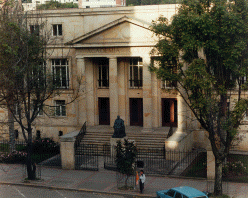
It hosted the Third Congress of Academies (1960), in which the Agreement of Bogotá was presented and signed.
Its library is divided into three branches:
1. Antonio Gómez Restrepo Library acquired in 1971, which has 18,000 volumes of books for research use only.
2. General Reference Library, with 17,000 volumes for public research in general.
3. Information Office Library, which has 2,000 books for student consultation.
The traditional functions of the academy, and all schools that comprise the Association of Spanish Language Academies, consisted of the development, dissemination and updating of the 3 sets of rules of any language: spelling, dictionary and grammar, to maintain the purity of the language free of any type of incorrect foreign influences.
Today the role of the academy, with the words of its own region, is to maintain the basic unit of language, a task that is achieved through the teamwork of all schools under the supervision of the SAR. That is why the publications are not “personal”, i.e. they are not “signed” by one of the academies that are part of the whole, the Association of Spanish Language Academies, but the publications have a Panhispanic orientation, i.e. that are “signed” by the entire team: all the academies of the Association of Spanish Language Academies under the leadership of the Spanish Royal Academy since the publication of the 1999 Spelling. This is what allows us to speak today of a “Spanish speaking community” that maintains the unity of language while recognizing internal variants.
Teams of specialists working today in the Colombian Academy of the Spanish Language study the evolution of words through two great works of the Royal Spanish Academy:
1. Diachronic Corpus of Spanish, CORD, which contains 300 million forms from the origins of language until 1974, and
2. Corpus for current Spanish reference, CREA, which now has 150 million word forms in texts from 1975 onwards.
Corpus of Spanish in the 21st Century
While the CREA was scientifically sound at the time of its creation, it was rendered obsolete by new needs. Thus, at the Medellín Conference of Academies in March 2007, it was decided to undertake the creation of a new corpus with 25 million forms for each of the years between 2000 and 2011 and with the following distribution of the source of text: 30% for Spain and 70% for America. That is why on June 14, 2007, Victor Garcia de la Concha, director of the Royal Spanish Academy, and Emilio Botin, chairman of Santander Bank signed an agreement for the preparation of the Corpus of Spanish in the 21st Century, a project of the SRA in collaboration with the Association of Spanish Language Academies.
The corpus of reliable linguistic data radically changed the way they work in the Royal Spanish Academy and the Association of Spanish Language Academies.
Specifically, the Dictionary of the Spanish Royal Academy, the Pan-Hispanic Dictionary of Doubts, the Student Dictionary and the Essential Dictionary have significantly benefited from the contributions of the corpus. Moreover, these sources are the basis for subsequent publications.
The creation of this new body has a core team working on the premises of the Royal Spanish Academy and numerous collaborative teams from various universities throughout Spain and America.
This project has been endorsed by the Santander Universities Global Division of Banco Santander, which between 1996 and 2006 allocated 400 million euros to finance academic projects and assist in the dissemination and teaching of Spanish.
(Versión en español: Academia Colombiana de la Lengua)





